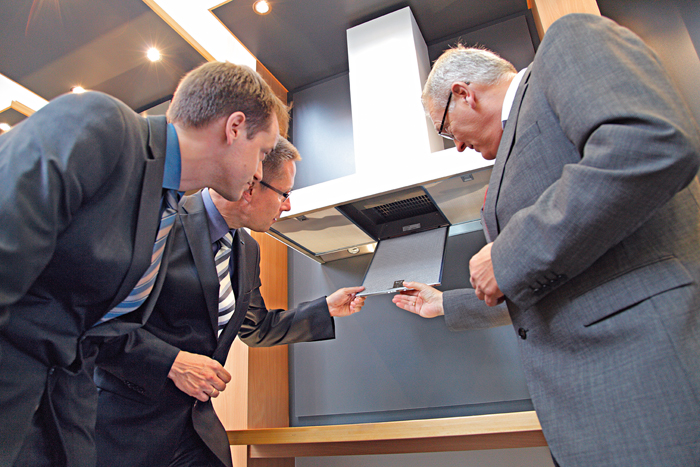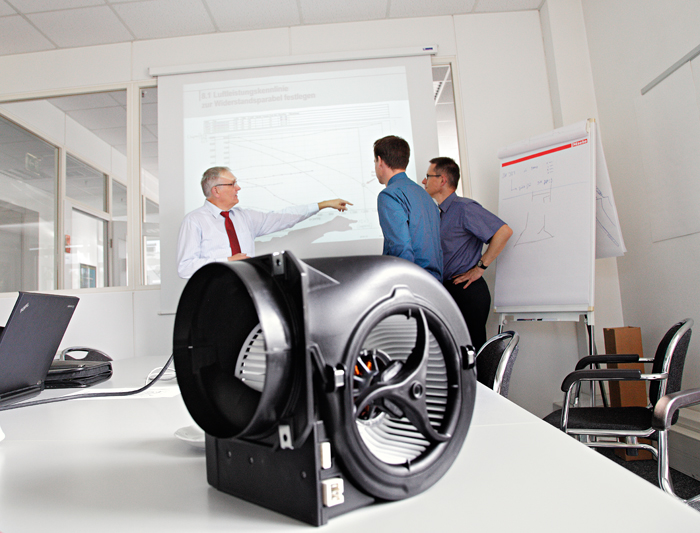A kitchen is not only a place for cooking or having a chat, it is also a source of considerable power consumption: It offers tremendous potential for savings, from the fridge right through to the stove. A fact of which kitchen appliance manufacturers are also well aware. “Nowadays energy efficiency is at the forefront of people’s minds,” explains Rainer Ragert, head of development at the Arnsberg plant of the Miele subsidiary imperial, the Miele Group’s centre of excellence for range hoods. “So we put some thought into how we could pick up on this development and make our products even more efficient.”
The solution: Forever better
Ragert is himself involved in the creation of a new EU-wide energy efficiency label designed to show consumers at a glance whether or not a range hood for example is fitted with power-saving technology. At a joint meeting in Mulfingen, engineers from both companies therefore took the decision to develop a special blower with particularly low energy consumption. “We knew that the EC motor from ebm-papst already fulfilled the corresponding technological requirements,” explains Rainer Ragert. “But certain modifications to the motor were still necessary to suit our purposes.” In keeping with the Miele motto “Forever better”, we wanted to work together to come up with a solution which would be a real bonus to consumers: Quiet operation, reliable extraction – for small fitted kitchens, combined dining / kitchen areas and kitchen islands – and also greatly reduced power consumption. Miele is thus the first manufacturer to offer range hoods featuring EC technology. A conscious decision in favour of top quality in a highly competitive market.
Success of the pilot model
The first step involved ebm-papst engineers bringing the dimensions and electronics of the EC blower into line with those of the AC blower previously used. Miele presented the world’s first range hood with EC technology in 2011. This pilot model was just produced in one size to try it out on the market. The highly innovative unit went by the name of “Eco package”. In view of the fact that the efficient hood met with a good reception from customers, Miele started equipping the next series with full EC technology. Miele then integrated a new control system specially matched to the ultra-modern EC blowers into their “Generation 6000”.
Coordination at many levels
On top of the purely technical aspects, there was another central challenge: “The crucial factors in this project were the limited time available and the need for coordination between lots of different people in different places,” explains Gerald Ehrler, project manager at ebm-papst. Three groups were working on the project at the same time: imperial Arnsberg on the range hood, Miele Gütersloh on the control system and ebm-papst in Mulfingen on the motor and control system coordination. At first the deadline set for the series launch looked almost impossible. But thanks to intensive cooperation, not least with managerial involvement and any number of coordination meetings, the engineers managed to overcome all the obstacles: In the end, the VDE approval required for the blower was obtained the day before the set deadline and the unit went into series production just in time.
Blower in coasting mode
All these efforts bore fruit: With energy efficiency as the main winning feature. “In the lowest speed setting the EC blower uses next to no power as it runs in the part load range,” explains Ehrler. “Like allowing a car to coast along at 120 kilometres per hour on a straight road.” ebm-papst engineers are still working on pressure stability and noise generation to find the ideal answers here as well.
A combined approach to saving
As a range hood is only used for around one hour a day on average, Miele combined the EC technology with other measures designed to reduce energy consumption even further. Stand-by consumption was reduced and new lighting elements were introduced for example. In the past, consumers only had the choice of good lighting with high power consumption or low power consumption but a poor view of the cooker. Miele now uses high-performance LED lights with a power consumption of only two watts each for illuminating the hob. Commercially available halogen lamps need around ten times the amount of energy. What’s more, the LEDs are designed to last for the entire lifetime of the range hood – in other words they never have to be changed in 20 years.
The working relationship of the various companies is also a long-term affair. A range hood blower jointly developed by imperial and ebm-papst 20 years ago is now accepted as the standard for the global market. “There are many points of contact between the Miele Group and ebm-papst and that has been the case for many years now,” says Rainer Ragert. “Because our aims are very similar: Development expertise, customer satisfaction, consistency and sustainability.”




Leave a comment